Quick start guide for Yoast SEO for Shopify
With this quick start guide, we explain what Yoast SEO for Shopify can do for you. We explain how you an access Yoast SEO, the features and other important settings.
Want to know more? You can also do the Yoast SEO for Shopify course. It will teach you to use all the great features of Yoast SEO to their full potential!
How to access Yoast SEO for Shopify
There are several ways to access Yoast SEO in Shopify.
How to access Yoast SEO via Apps
- In your Shopify admin, go to Apps
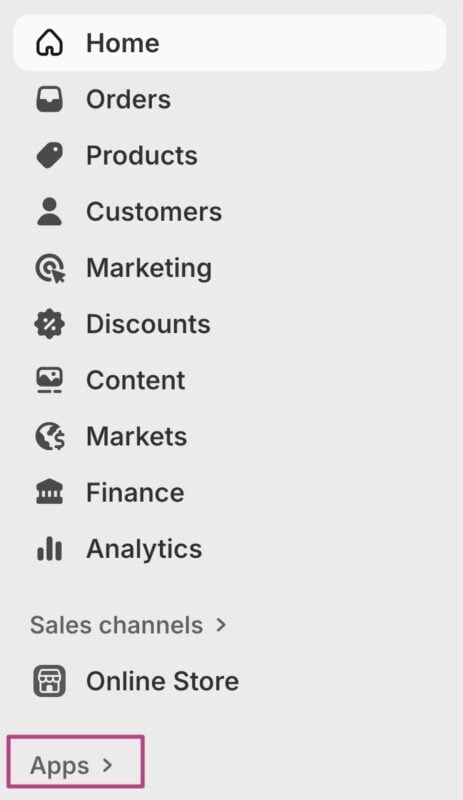
- Search for and go to Yoast SEO

How to access Yoast SEO via More actions
- In your Products or other pages, go to More actions

- Go to Optimize in Yoast SEO

How to access Yoast SEO via the Shopify sidebar
- In your Shopify admin, go to Apps

- Search for and go to Yoast SEO

- In the sidebar, pin Yoast SEO
The pin appears when you hover over the app.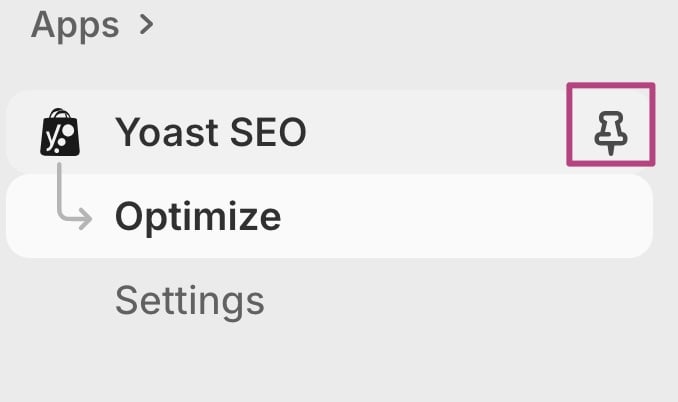
What to do first after installing Yoast SEO for Shopify
- Pin Yoast SEO to your Shopify sidebar
- Fill in the Site representation settings
In the Yoast SEO Settings, under Schema, you’ll find Site representation. Here, fill in all the relevant information about your site, so that you may get featured in a Google knowledge panel.

You can also add the social media profiles that belong to your organization.
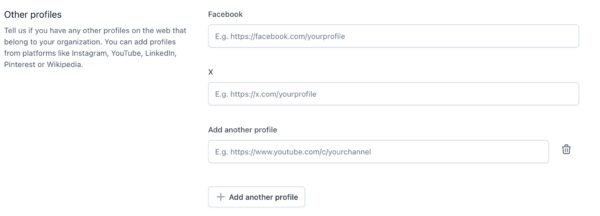
3. Set your Site basics
In the Yoast SEO Settings, under Site settings, you’ll find Site basics. Here, set the items below.
- The Site title and Separator: this sets default template for the SEO title of your site, which appears in search results. It acts as a backup if you don’t fill in an SEO title for individual pages.
- The Site image. It acts as a backup if you don’t provide an image for individual pages.
- Turn on the inclusive language analysis if you want to be notified when you use language that excludes people. The analysis will also give you suggestions for inclusive alternatives.
4. Optimize your first product page
Now you’ve filled in the most important settings, it’s time to start optimizing. In the remainder of this page, you’ll find an in-depth explanation of optimizing your product pages. But here, we’ll give you a quick overview of the most important things you should do.
First, once you’ve accessed the Yoast SEO app, pick out your most important product page. For every product page, there are five things you should always do:
- Fill in your Focus keyphrase; this is the keyphrase that you’d like to rank for.
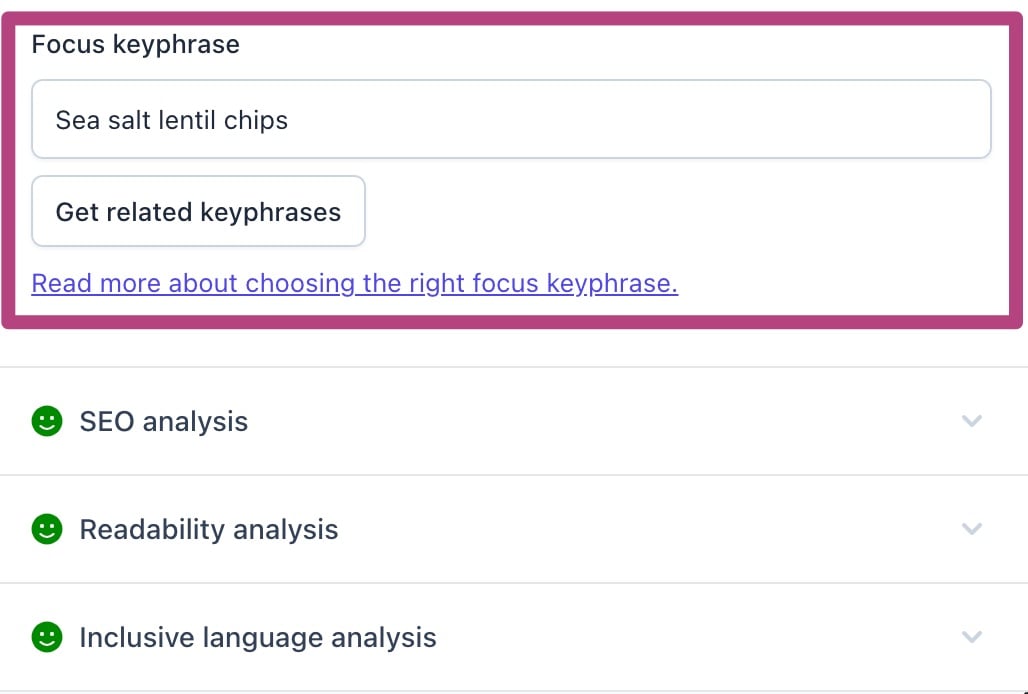
- Make your product page SEO-friendly with the SEO analysis.
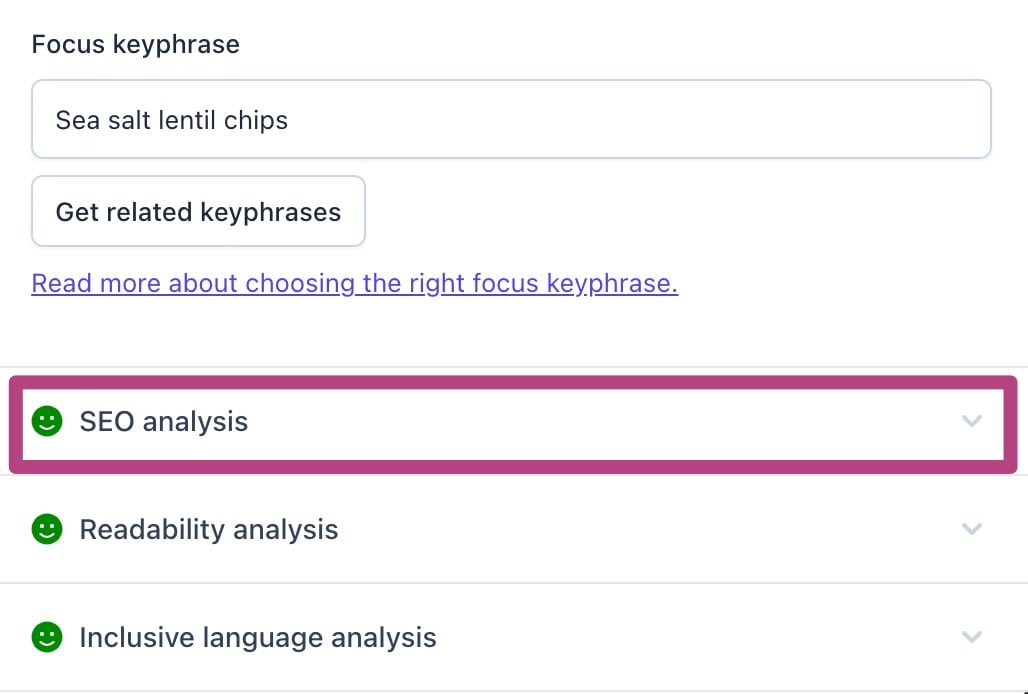
- Make the content of your product page readable with the Readability analysis.
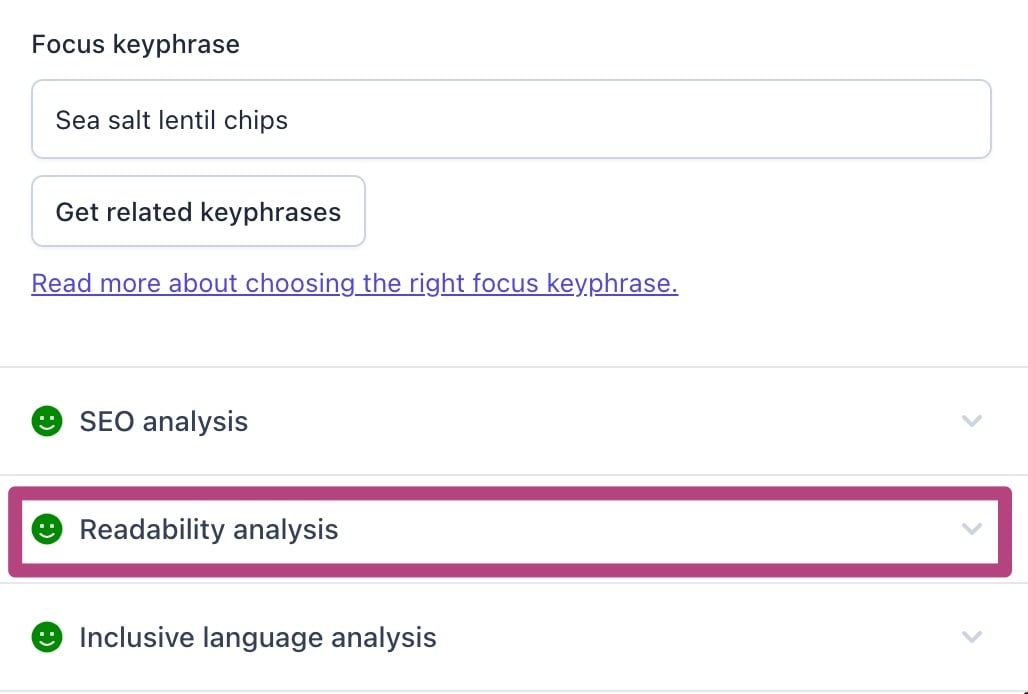
- If you activated this, please ensure your content passes the inclusive language analysis.
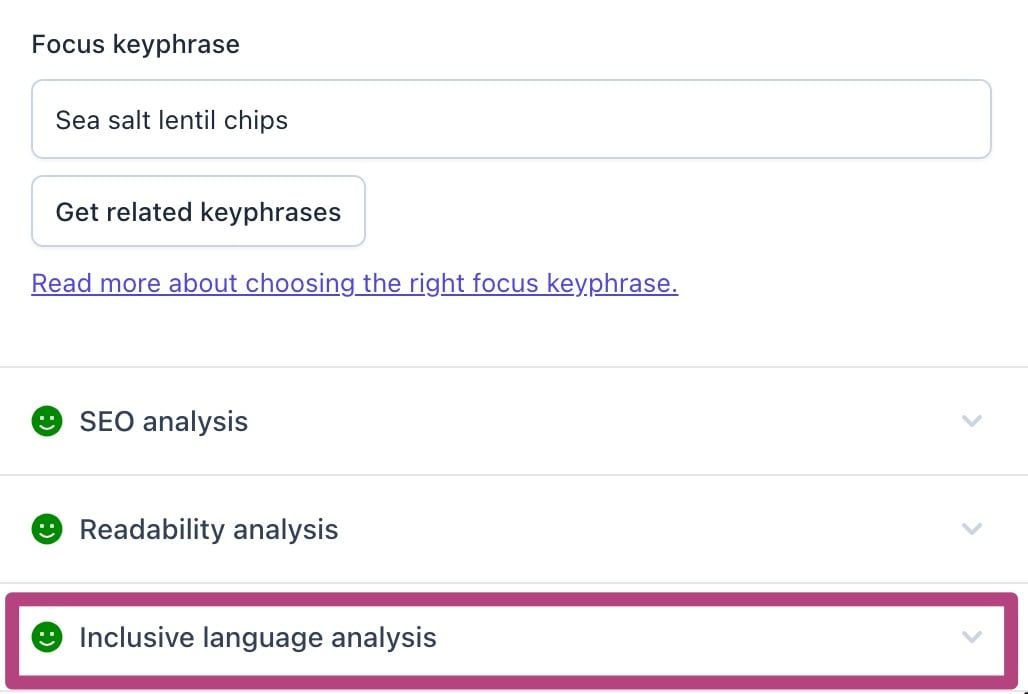
- Optimize your SEO title and meta description in the Search appearance and Social media appearance section.

Great, now you know how to get started with Yoast SEO! But, to learn about everything the app can do for you, we advise you to keep reading.
How to optimize your product pages with Yoast SEO
Yoast SEO helps you write product pages your customers will love. In addition, it assists you in preparing your content for search engines. It guides you in writing easy-to-read content and ensures you correctly use the keyphrases you want to rank for.
Yoast SEO offers Readability, SEO, and Inclusive language analysis for all your content types. In this article, we focus on the Product page analysis, but the analysis is also available for Blogs, Pages and Collections.
Readability analysis
The readability analysis contains various checks designed to make your product descriptions easier to read and understand. When customers find it easy to get what your product is and why you are selling it, they are more likely to buy it.
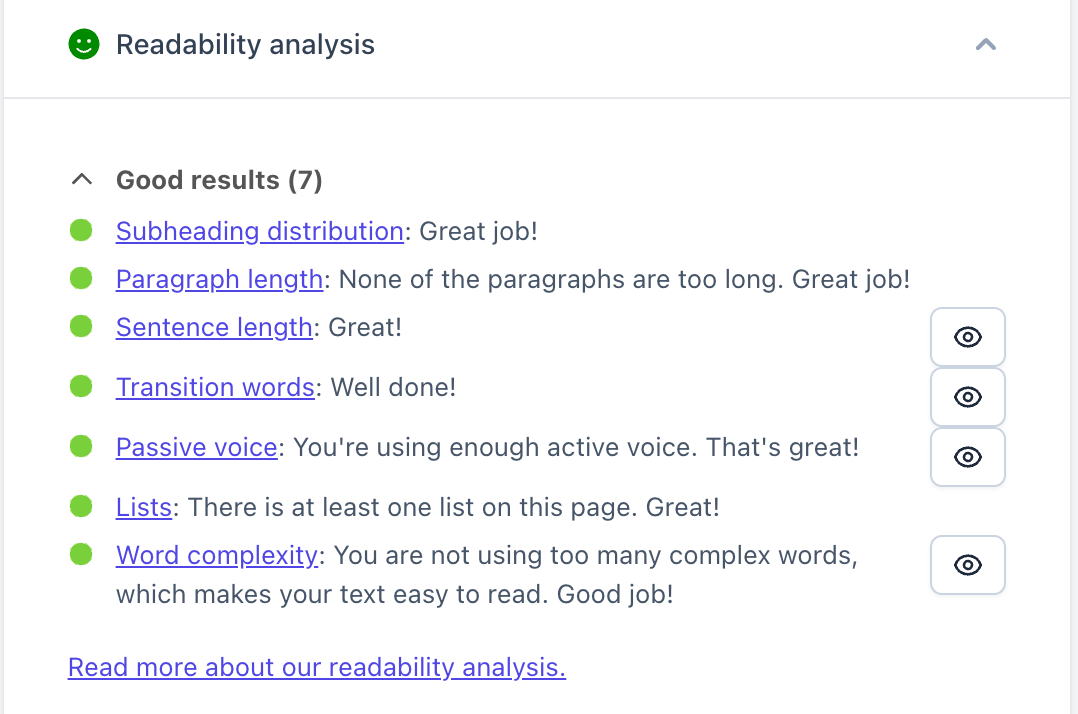
Yoast SEO contains the following checks to make your descriptions easier to read.
Lists
Lists make your product pages easier to scan, so people can quickly find what they need. This check will give you a red traffic light if there are no lists on your product page and a green one if the page has at least one list.
Transition words
Transition words help you create a flow between your sentences and paragraphs. The transition words check works only if your product description is at least 200 words.
Passive voice
Using too much passive voice can make your content difficult to read. So, this check assesses whether the number of sentences containing passive voice exceeds the recommended maximum amount. The amount will vary depending on the length of your content.
Sentence length
Using too many long sentences can get in the way of delivering your message. Yoast SEO will warn you if many sentences contain more than 20 words.
Paragraph length
Writing short and focused paragraphs can help customers scan your product page and easily digest the information. Yoast SEO gives you an orange or a red traffic light for product pages if the paragraphs exceed the recommended maximum length of 100 words.
Subheading distribution
Adding subheadings is another way to make your product pages easier to scan. Please note that this only applies to longer descriptions: if your product description contains more than 300 words, the app will suggest adding subheadings.
Word complexity
Yoast SEO for Shopify also analyzes the complexity of the words you use to write about your products. Too many difficult words make it harder for people to understand what you mean or what your product does.
The SEO analysis helps search engines understand your content
With the SEO analysis in Yoast SEO, you ensure that your product descriptions are focused on the keyphrase you want to rank for.
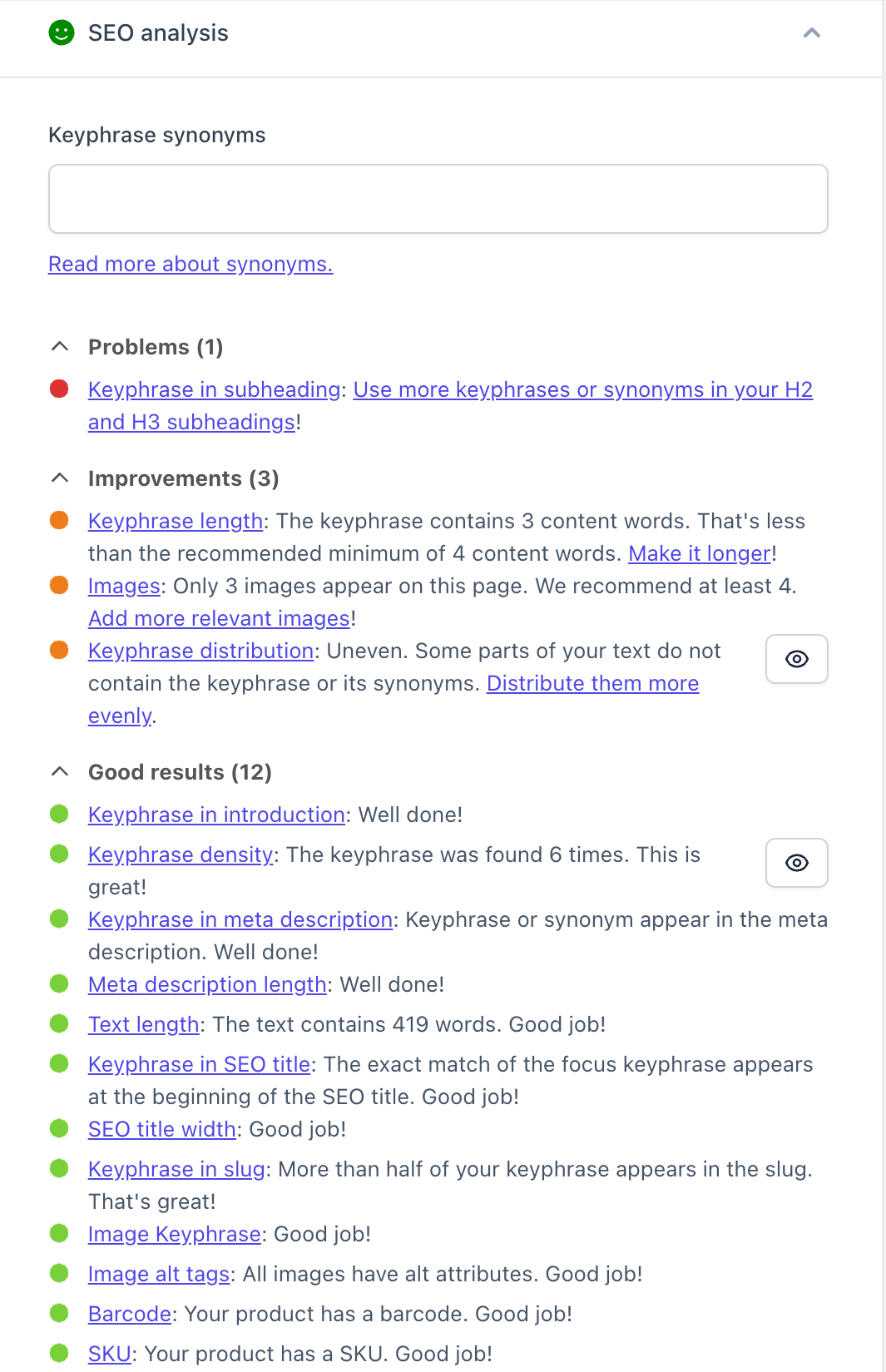
Keyphrase in introduction
Using your keyphrase in the introduction of your product description will immediately clarify what that product is about. This check ensures that your keyphrase can be found in the first paragraph of the text.
Keyphrase distribution
Your keyphrase should be repeated throughout your content: not just the beginning or the end. Yoast SEO makes sure your keyphrase is evenly distributed throughout your content.
Keyphrase density
You write your product pages to convince customers to buy your products, but search engines also need to understand the product. So, the keyphrase density assessment checks whether the (content) words from the keyphrase are used in the text and whether they are used often enough. For the app to recognize the keyphrase, you should use all the keyphrase content words in one sentence.
The keyphrase length
To increase your chances of ranking, we recommend optimizing your content for a long keyphrase. This assessment checks whether the keyphrase’s (content) words are within the recommended limit, between 4 to 6 words.
Keyphrase in meta description
The meta description is the short text that appears in the search results. You can use your focus keyphrase in the meta description to make your product page stand out in the results. Search engines often highlight it, making it even more visible to customers. This assessment checks whether you’ve used all (content) words from the keyphrase in the meta description.
Keyphrase in subheadings
Like the people who land on your product page, search engines use subheadings to scan the content and determine what the page is about. Keywords help them understand the page. So, this assessment checks whether H2 and H3 subheadings reflect the topic of the copy, based on keyphrases or synonyms. For languages with function word support, a subheading is considered to reflect the topic if at least half the words from the keyphrase are used. For languages without function word support, a subheading is considered to reflect the topic if all content words from the keyphrase are used.
Keyphrase in title
The title of a page is among the first things people see. That’s why it is crucial to use your keyphrase in the title. Yoast SEO checks if the keyphrase is used in the page title. When function words precede the keyphrase in the title, they are filtered out when determining the position of the keyphrase in the title.
Image alt tags
Images need to be understood by search engines and people who use screen readers. You can facilitate that by adding alt tags to your images.
Image keyphrase assessment
Ideally, when adding alt-tags to images, use your keyphrase and make it abundantly clear what your image is about. It checks if there are keyphrase or synonyms in the alt attributes of images.
Competing links
Search engines use links to understand pages. So, optimizing a page for a particular keyphrase and then using the same keyphrase in an anchor text to link to another page may confuse search engines. They may have trouble understanding which page to rank better. Yoast SEO ensures you avoid this by checking whether links in the text use the keyphrase as their anchor text.
The text length
This check makes sure your content contains at least 200 words. By doing that, it encourages you to give all the necessary information customers may need about a product.
Slug keyword assessment
Adding the keyphrase in the URL slug gives an additional hit to search engines about the page’s content. You’ll also find a check that ensures you’ve included your keyphrase in the slug in the Yoast SEO analysis.
Images and videos
Images and videos are crucial on product pages since they show the product to your customers and convince them that it is as good as you claim it to be! This check ensures you have at least one image or video on your product page.
The meta description length
A meta description is like a pitch for your product. But, if your meta descriptions are shorter, you risk having them cut off in the search results, which may lead to losing some valuable information. Yoast SEO checks if your meta description has a length between 120 and 156 characters.
The SEO title width
The SEO title is the title that appears in the search results. So, besides the page’s title, it can also contain a separator and/or the site’s name, for example. If the SEO title is too long, it may get cut off. That’s why Yoast SEO checks if your SEO title is of good length. Just so you know, this assessment checks the SEO title as it appears in the snippet preview. Therefore, it also takes into account the content from replacement variables.
Barcode
Product identifiers are essential for ecommerce SEO. Yoast SEO for Shopify ensures you remember to add these. It comes with a check for product barcodes.
SKU
Similarly, Yoast SEO for Shopify checks if you’ve added an SKU for your product.
Adding synonyms and related keyphrases
Yoast SEO runs a lot of checks for your focus keyphrase. However, add keyphrase synonyms that the app considers when running the analysis to make your writing more engaging and varied. In addition, you can add related keyphrases, which will have a separate analysis. You can also find and add related keyphrases with the Semrush integration.•
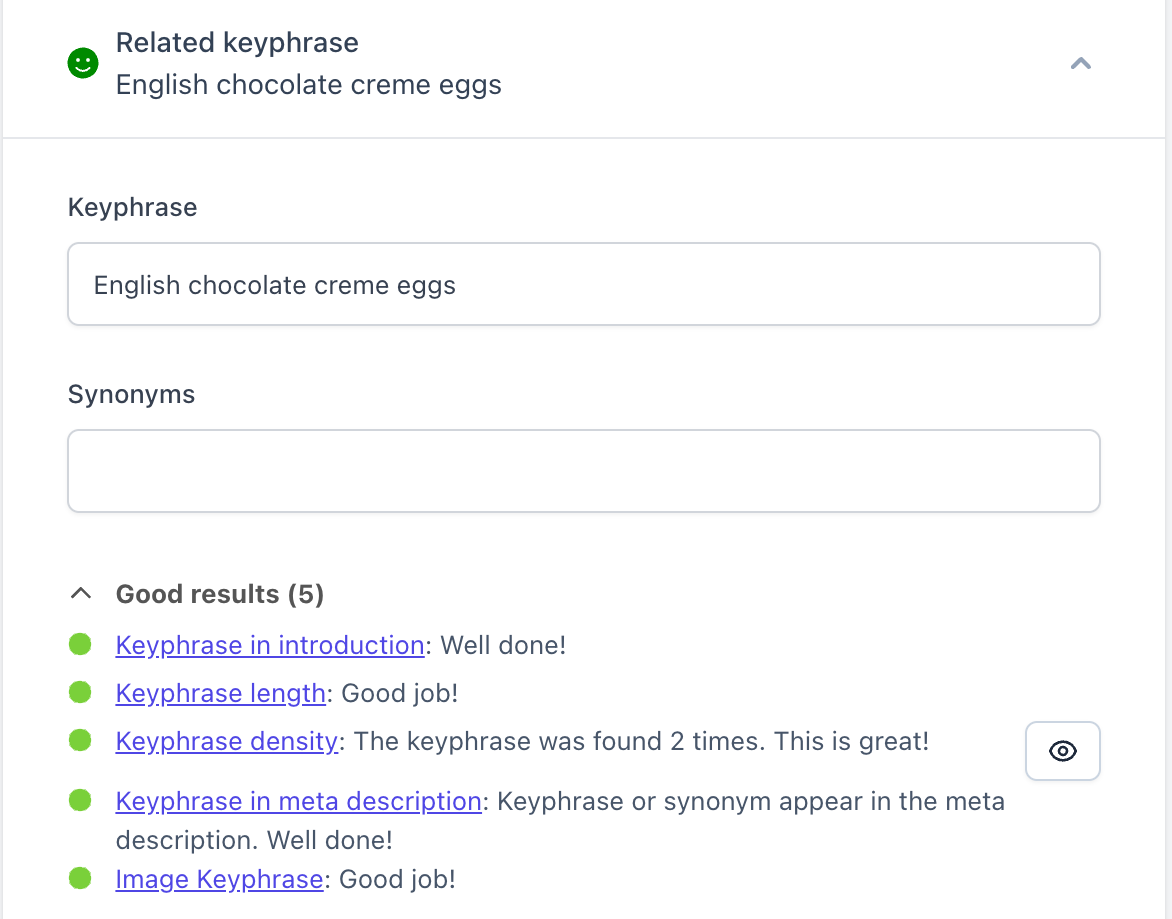
The Schema tab
Yoast SEO automatically describes your pages using Schema.org. This helps Google understand your website and your content. As a result, Google may feature your products in the Google Shopping section or display them as rich results. For Products, you cannot change the default Schema we output. However, if you are writing a blog post or a page, you can choose the type of Schema Yoast SEO outputs.
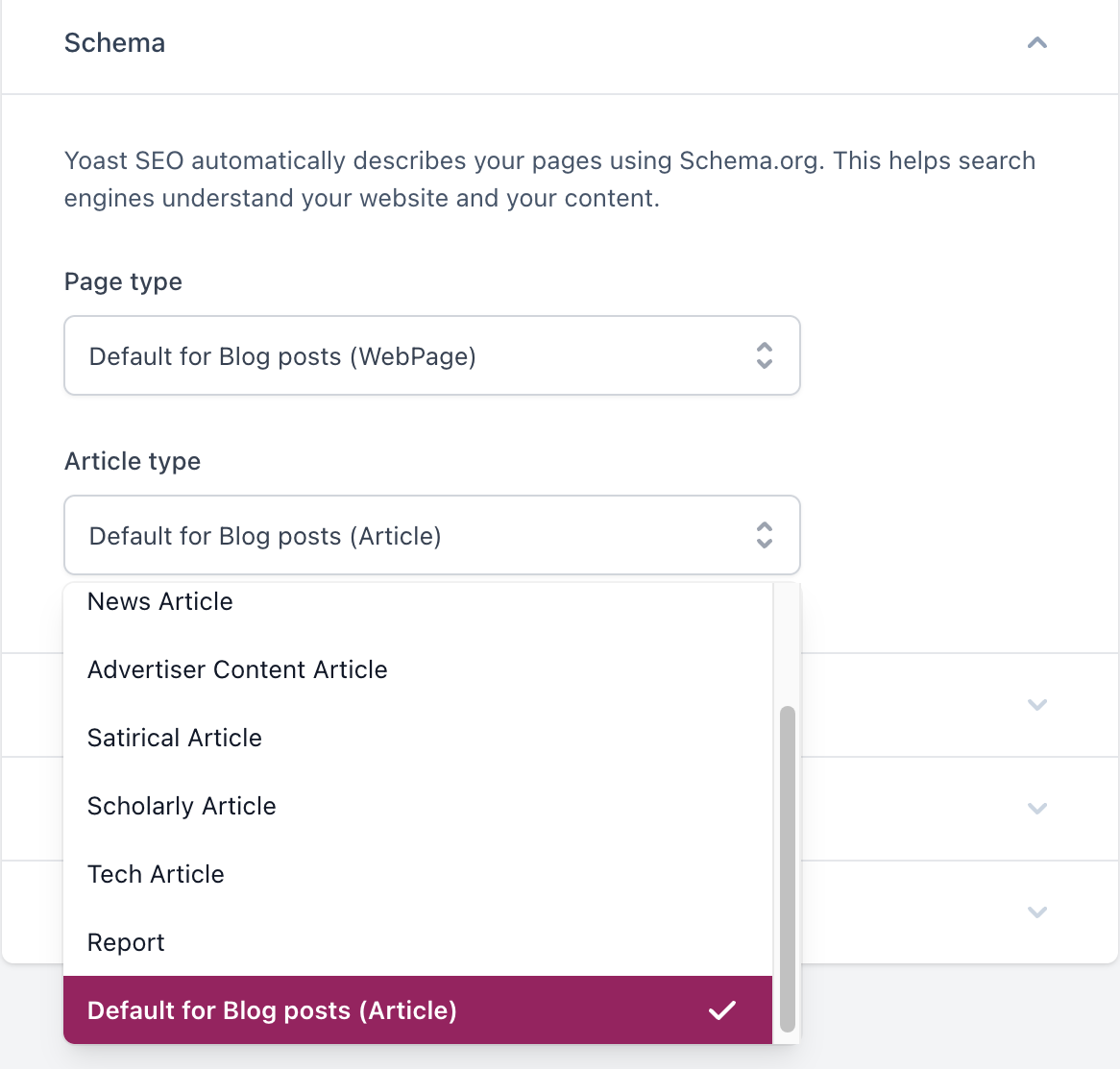
Guiding the search engines
The Advanced settings allow you to decide what to show to search engines and, by extension, what shows up in the search results. For instance, you can hide the entire page or parts of it, such as the links or images. Moreover, you can instruct search engines not to show a snippet of the page or its cached version.
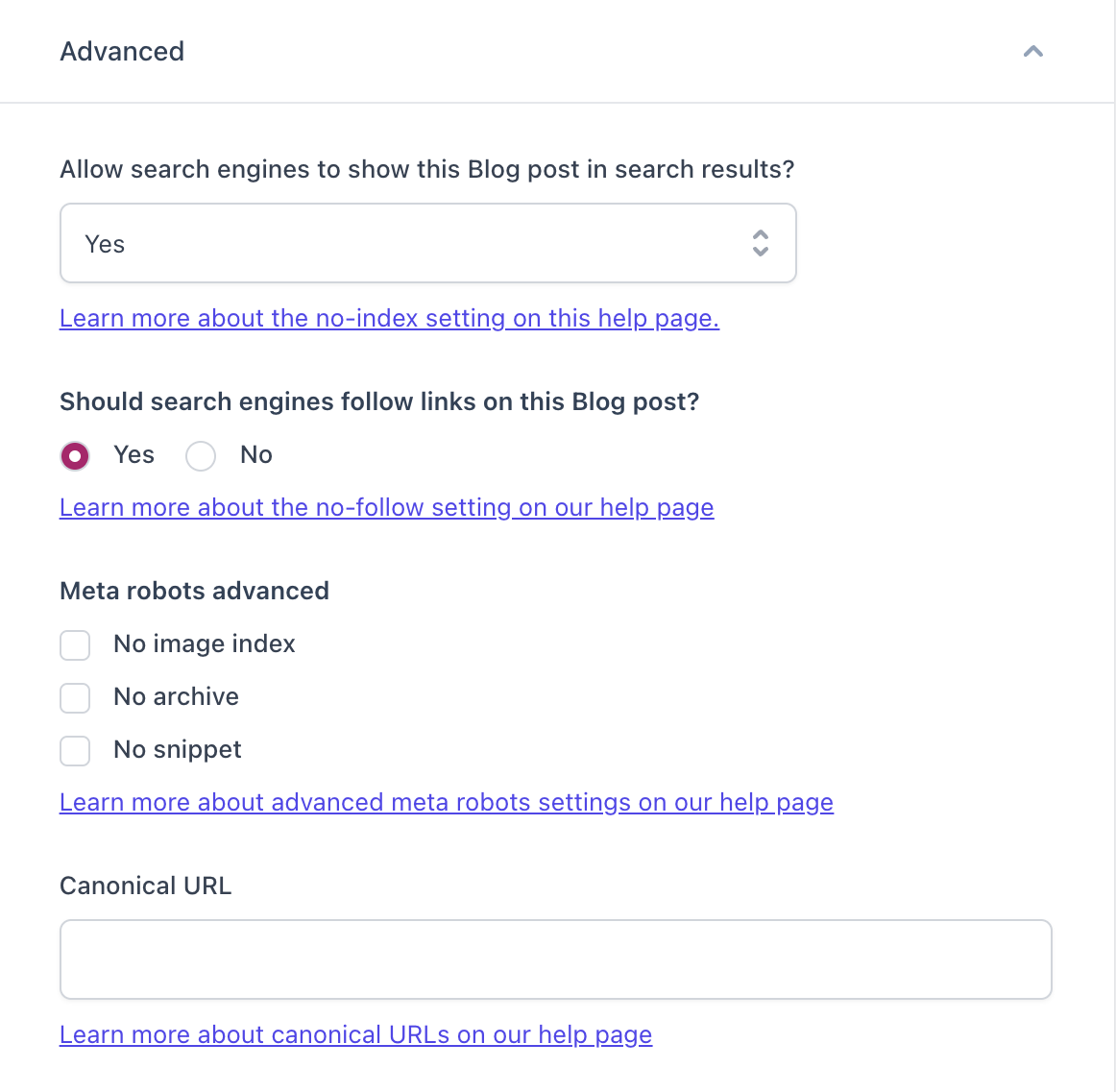
Cornerstone content
Cornerstone content is the most important content on your site. For example, a product you always have in stock or a product that sells the most in your store can be your cornerstone. If you mark a product, a page, a blog, or a collection as cornerstone content in Yoast SEO, the SEO analysis will be stricter. This is because cornerstone content is the one you typically want to rank highest and should, therefore, be the best.

For example, we check if your content is long enough. That means we expect a cornerstone product page to have at least 400 words. We’re stricter with some of the keyphrase checks. We want to ensure you use the keyphrase often enough and in the right places.
The Yoast SEO analysis for other content types
As mentioned earlier, Yoast SEO for Shopify also checks the readability and the SEO of all other content types.
Collections content analysis
For Collections, the SEO and Readability analysis is the same as the analysis for product pages.
Blogs and Pages content analysis
The Readability analysis for Blogs and Pages is the same as the analysis for product pages. The SEO analysis has additional checks for Outbound links and Internal links: it checks if they are present and followed.
How your pages will look on the SERPs and social media
Besides ensuring your content is well-optimized and easy to read, Yoast SEO also helps you control what your pages look like in the search results or when they get shared on social media.
Search appearance
The search appearance feature lets you preview and edit the page snippet that will appear in search engines. So, you can choose the title (including a separator and/or your site’s name), the slug (the last part of the URL), and the meta description. The preview is available for mobile and desktop, so you can better understand your page’s appearance across different platforms.

You can also edit your snippet in Shopify! If you’ve already set a title and product SEO title templates, Yoast SEO will override the original Shopify title with the Yoast SEO title template. Did you add a meta description in Shopify? It will appear here, so you can check the Yoast SEO feedback and edit where necessary.
Did you create a product template for your meta descriptions in the Yoast SEO Content settings? Go to the Shopify editor and delete the description there. Then, return to the Yoast optimizing screen, and you’ll see your template!
Social media appearance
With the social media appearance, you can decide what your page will look like when you, or someone else, share it on social media like Facebook and X. You can add a title, a description, and an image. By editing and previewing the page and what it would look like when it gets shared, you can make it stand out in the sea of social media posts. And that might get you more traffic to your site!
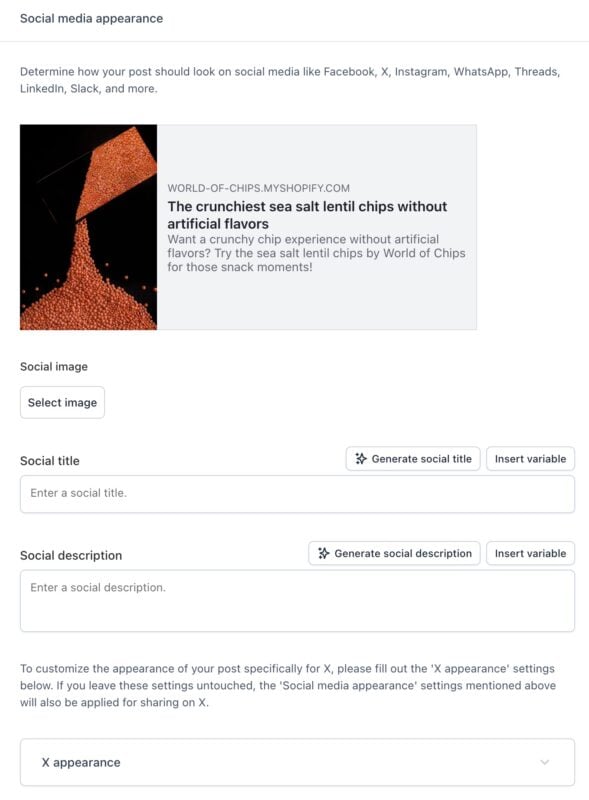
Bulk editing in Yoast SEO for Shopify
Yoast SEO lets you easily export a CSV file with all your SEO metadata, edit it, and import it back for easy bulk editing
Showing your product reviews in search results
If you want your product reviews to appear in the search results, you can integrate Fera and Yoast with your Shopify store. This combination of apps enhances your store’s reviews and visibility in the SERPs. Wondering how that works? Yoast SEO takes the rating from the Fera reviews app and translates it into a language that search engines can understand, called structured data. Read more on how to get your product reviews to show in the search results with the Fera integration in Yoast SEO for Shopify.
The Settings tab in Yoast SEO
When you access Yoast SEO via Apps, you will see Optimize and Settings.
About
When you open the Settings, you’ll see the About tab first. You’ll find important information about our app, your subscription details, and the option to apply a discount code or upgrade your subscription. In addition, you’ll find a link to the Changelog, where all the important app updates will be listed.
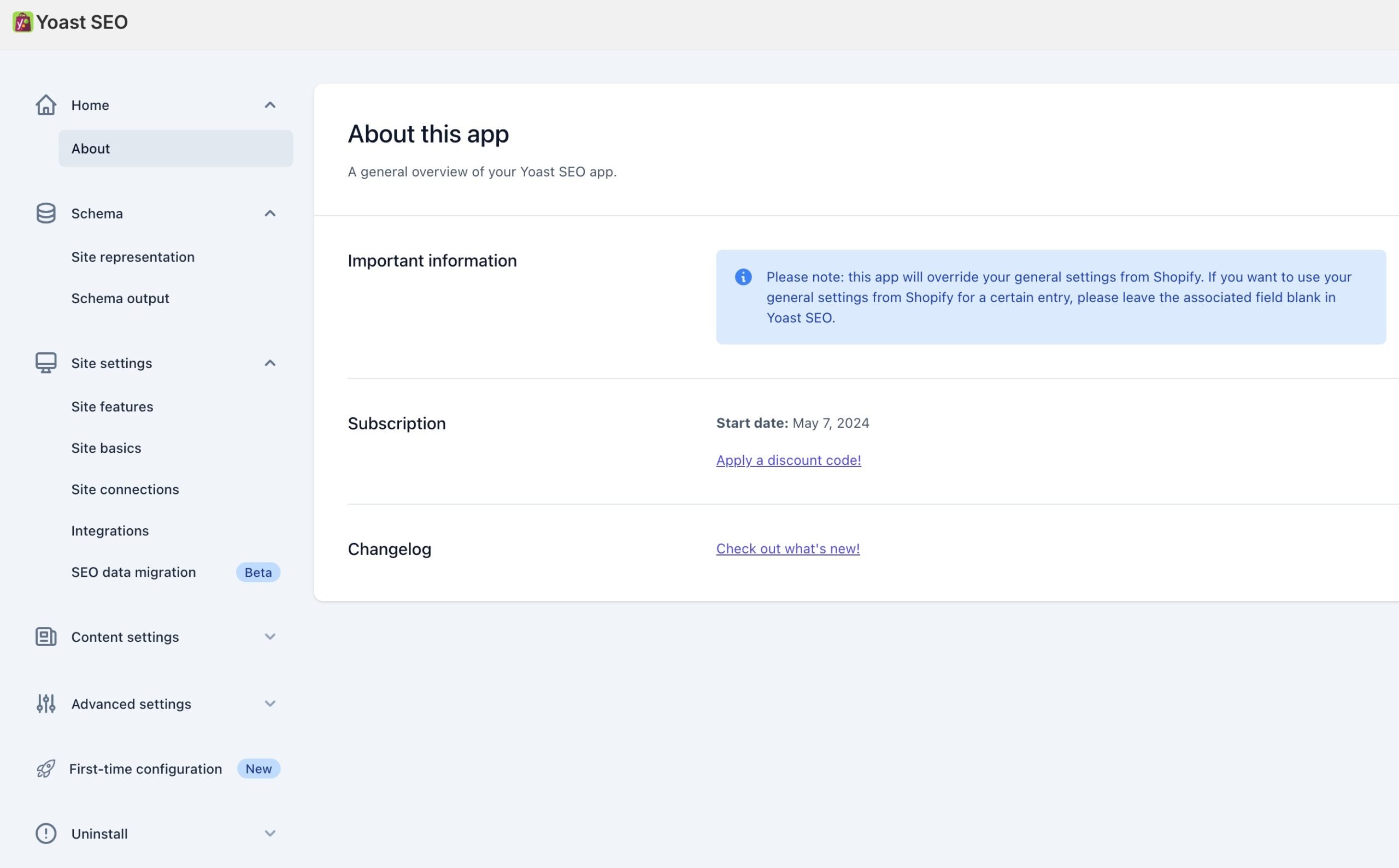
Schema
Site representation
With these settings, you can give Yoast SEO the essential information to feed Google’s knowledge graph. For example, you can add your organization’s name, logo, and social profiles. You can also specify the site name and alternate site name of the website. As a result, you may get your site featured in a Google knowledge panel and increase your visibility in the search results.
Schema output
With these settings, you can choose which parts of Schema.org markup you want to disable for your site. Please note that changing Schema settings here can impact other parts of you Schema.org markup. We advise you to keep all the Schema toggles on, unless you use other apps that output the same Schema.
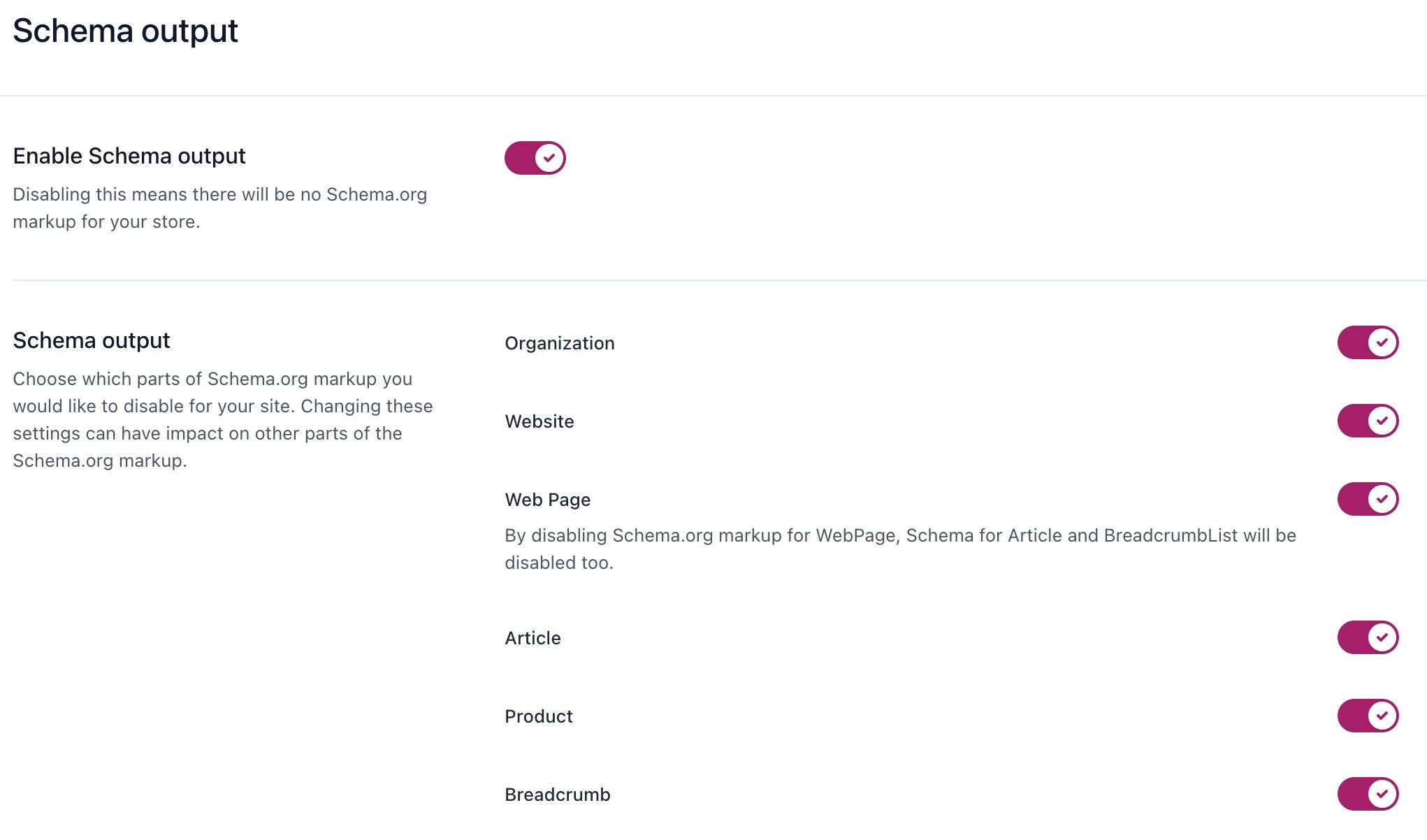
Site settings
With these settings, you can set some defaults for your entire site or content types. We advise you to use the Yoast SEO defaults, which will override the Shopify settings.
Site features
Under Site features, you can enable or disable certain site features, such as the inclusive language analysis and Yoast AI.

Site basics
Under Site basics, you can choose how you your site appears in the search results. This acts as a default template for all your content types. You can override the default settings for indiviual content items in the Yoast SEO app.
- The Site title and Separator: this sets default template for the SEO title of your site, which appears in search results. It acts as a backup if you don’t fill in an SEO title for individual pages.
- The Site image. It acts as a backup if you don’t provide an image for individual pages.
- Turn on the inclusive language analysis if you want to be notified when you use language that excludes people. The analysis will also give you suggestions for inclusive alternatives.

Site connections
The site connections settings let you verify your site with different webmaster tools by clicking Start scan. With webmaster tools, you can see your site’s performance in search engine results and how to improve it.
Yoast SEO automatically adds a meta tag to your homepage to verify your ownership of the site: you can find verification instructions by following the links in the description. If you are unsure, refer to our documentation for guidance on website verification. Your website’s verification status can be confirmed without completing the menu options.

Integrations
Yoast SEO for Shopify can also integrate with other apps. Currently, we have an integration with Semrush, the leading digital marketing platform. Activating this integration helps you do keyword research from inside the Yoast SEO app using Semrush data.
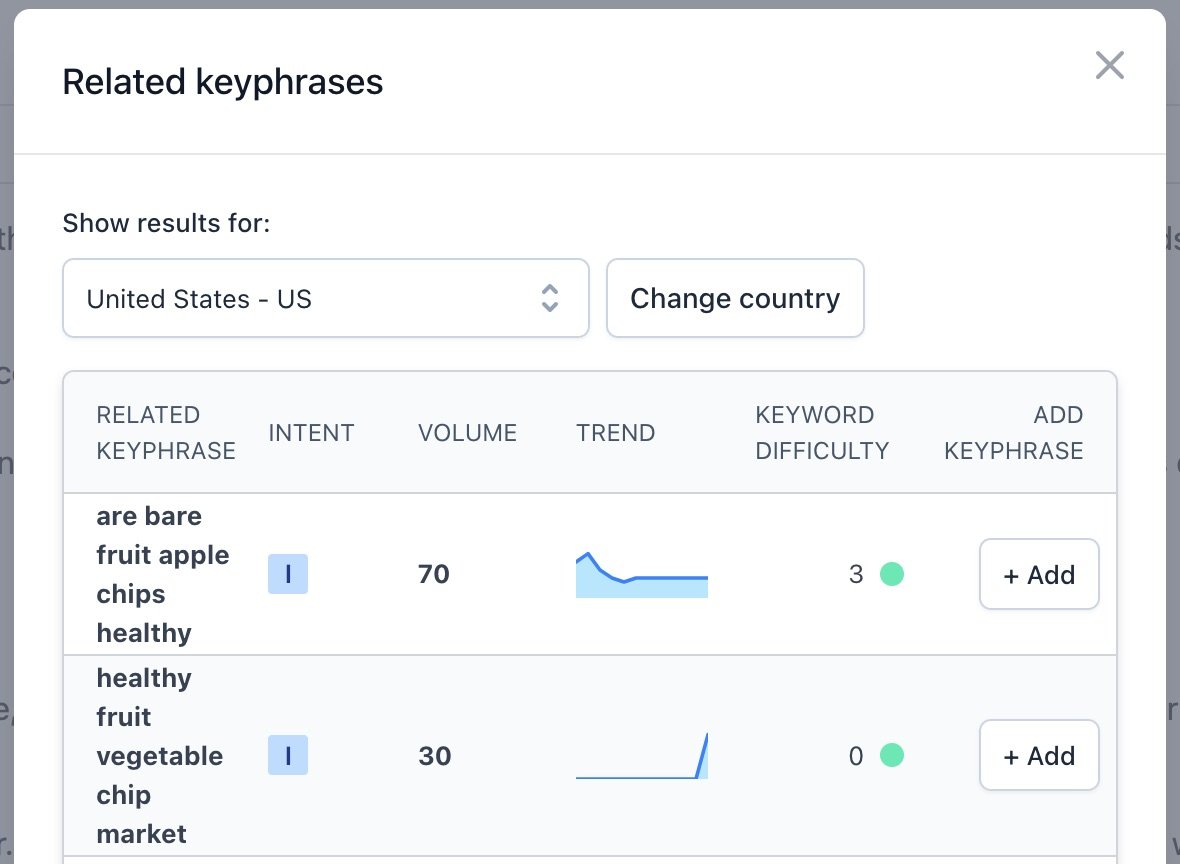
SEO data migration
With the SEO data migration in Yoast SEO, you can import your data from another SEO app to Yoast SEO. You will, however, need to use a third-party app to export the data. You can read all about it in our SEO data migration guide. This feature is currently in beta.
Content settings
The content settings tab lets you decide if and how the different content types, including your homepage, appear in the search results. In the content settings, you can set templates for SEO titles and meta descriptions for your content pages before doing individual optimization of the pages. In our documentation, you can find more on these Content settings.
For each content type (e.g., product page, collection, blog), you can decide:
- the SEO title;
- the meta description;
- the schema settings (only for the homepage, blog posts, and pages);
- The search appearance of the archive pages. Archives are an overview of all collections and products.
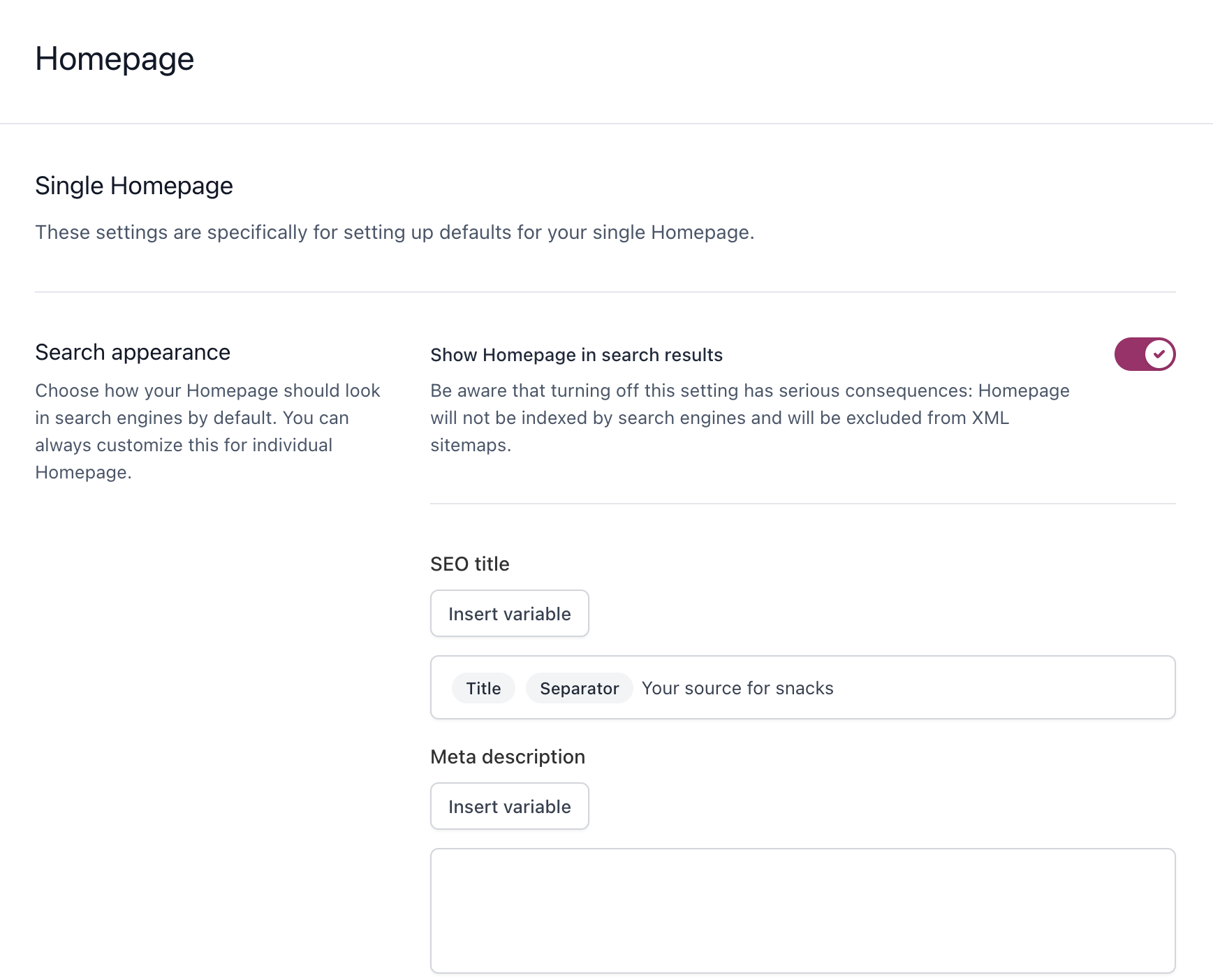
Advanced settings in Yoast SEO
Search pages and 404 pages
You can set the search appearance of the Search pages and 404 pages in these settings. If such a page appears in the search results, it’s good to set the title to clear up what the page is about and manage people’s expectations.
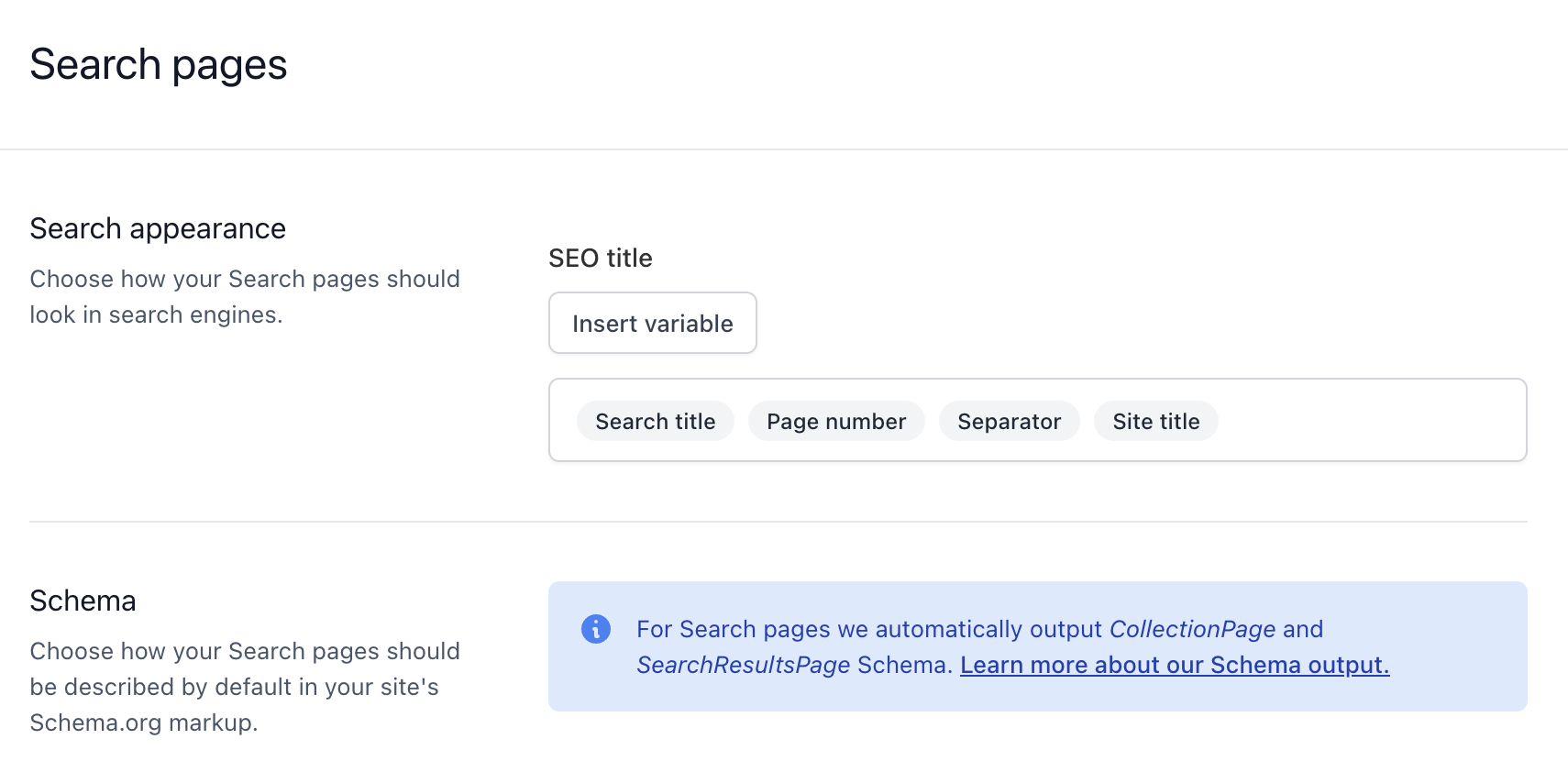
Theme integration
Under Theme integration, you can check whether Yoast SEO has succesfully been integrated, or remove Yoast SEO from your theme. Please note that removing Yoast SEO from your theme means Yoast SEO cannot work properly.
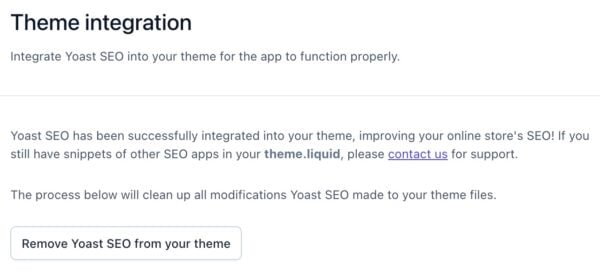
First-time configuration
If you haven’t completed the First-time configuration, you can complete the steps here. You’ll integrate Yoast SEO into your theme, set up your shop name and logo; and connect your social profiles.
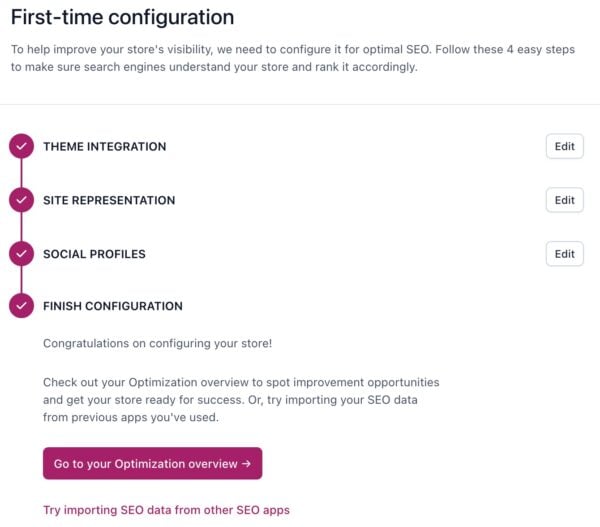
What should you do yourself?
Despite all these features, our app can’t do all the work for you. It can’t write awesome content, for example. You have to do that yourself. What it can do, however, is make it as easy as possible to work on your site’s SEO. In addition, these are some of the things you can check yourself.
Theme integration
The Yoast SEO for Shopify app makes changes and additions to a store’s theme files. It does this to optimize various aspects of technical SEO and to connect our content editing tools to the website’s output, while also offering the option to clear conflicting code coming from your Shopify theme or other SEO-related apps. Are you a developer? Then you can check if all the output is correct. To do so, you can use this overview of all our theme modifications on our Developer portal.
Schema implementation
Because many Shopify themes include isolated Schema pieces, we attempt to remove all existing structured data code and replace it with our Schema output. If you are a developer, you can check if all the Schema output is correct by checking this description of the Schema output for Yoast SEO for Shopify.
Implementing breadcrumbs
Yoast SEO also comes with breadcrumbs for Shopify. Depending on your theme, these can be implemented via the customizer or manually editing your theme. Our app uses Shopify’s breadcrumb structure, so no path customization options exist. Read more about how to implement breadcrumbs with Yoast SEO for Shopify.
What do you get with Yoast SEO for Shopify?
Using the tools and assessments in Yoast SEO for Shopify, all your pages will be well-written and ready to be shown in the search results. You’ll also be able to bulk edit your content and save time with Yoast’s bulk editor. In addition, you get top-quality customer support. Our expert support engineers are always ready to answer any questions you have! Plus, you’ll get unlimited access to all the Yoast SEO Academy courses, with an extensive library covering topics like keyword research, SEO copywriting, ecommerce SEO, etc.
Switching to and uninstalling Yoast SEO
How to switch to Yoast SEO for Shopify
Are you using a different SEO app for your Shopify store, but do you want to switch to Yoast SEO? That’s great! You can do that with the Importer feature in Yoast SEO.
Uninstalling Yoast SEO
If you want to uninstall Yoast SEO, you’ll need to remove the changes the app made to your theme and delete the app to cancel your subscription. We’ve made this process as easy as possible. Read more about how to uninstall Yoast SEO for Shopify.
Managing your subscription
Do you have questions about your Shopify subscription? Check out the most frequently asked questions about managing your Yoast SEO subscription for Shopify.
What happens to my work if I decide to delete your app?
You won’t lose any of your content or your search engine rankings. However, uninstalling and deleting the Yoast SEO for Shopify app means losing any optimization made in the Yoast SEO app. For example, you’ll lose focus keyphrases, custom social media titles and descriptions, etcetera. Any information in the Yoast SEO Settings will also be lost, such as site representation data and Schema output. Your Shopify data, like product titles and descriptions, won’t be affected.
If you have questions about your data after deleting the Yoast SEO app, feel free to contact our support team!
24/7 support
Do you have a different question? Our support team is available round-the-clock if you have Yoast SEO for Shopify. This means you can send us an email at any time or use the chat in the help beacon. Our experienced support engineers will gladly help you and answer your questions.
*Disclaimer: the Semrush account creation link provided in this article is an affiliate offering a 14-day trial period instead of the regular 7-day trial Semrush provides.

